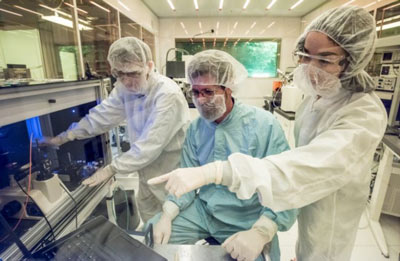
Combining speed with incredible precision, a team of Molecular Foundry scientists and industry users have developed a way to print a nanoscale imaging probe onto the tip of a glass fiber as thin as a human hair, accelerating the production of the promising new device from several per month to several per day.
The high-throughput fabrication technique opens the door for the widespread adoption of this and other nano-optical structures, which squeeze and manipulate light in ways that are unachievable by conventional optics. Nano-optics have the potential to be used for imaging, sensing, and spectroscopy, and could help scientists improve solar cells, design better drugs, and make faster semiconductors. A big obstacle to the technology’s commercial use, however, is its time-consuming production process. The new fabrication method, called fiber nanoimprinting, could unplug this bottleneck. It was developed by scientists at the Molecular Foundry in partnership with users from Hayward, CA-based aBeam Technologies.
Their work builds on the Campanile probe, which was developed by Molecular Foundry scientists four years ago and enables spectroscopic imaging at a resolution 100 times greater than conventional spectroscopy. Fabricating Campanile probes has been part science and part art. The same applies to other nano-optical devices, such as microscopic lenses and beam splitters, which split one light beam into several. These devices require milling a 3-D shape with sub-100-nanometer scale features on the tip of a wispy fiber, which is much trickier than fabricating a nanostructure on a flat surface such as a wafer.
That’s where fiber nanoimprinting come in. Its first step is the most time consuming: scientists create a mold with the precise dimensions of the nano-optical device they want to print. For the Campanile probe, this means a mold of the probe’s nanoscale features, including the four sides and the light-emitting 70-namometer-wide gap at the pyramid’s top. After the mold is created, it is filled with a special resin and then positioned atop an optical fiber. Infrared light is sent through the fiber, which enables the scientists to measure the exact alignment of the mold in relation to the fiber. If everything checks out, UV light is sent through the fiber, which hardens the resin. A final metallization step coats the sides of the probe with gold layers. The result is a quickly printed—not meticulously sculpted—Campanile probe. By doing this over and over, the team can make a probe every few minutes.

